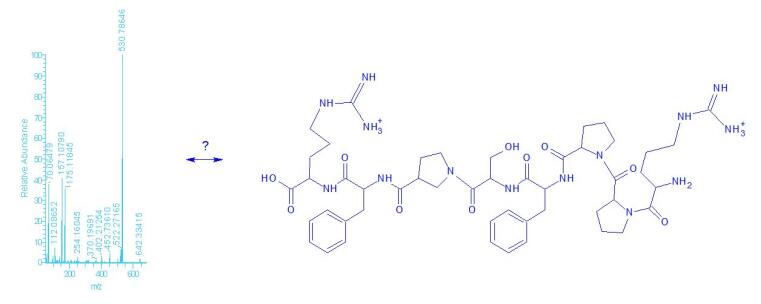Spectra Quotation
How to cite Mass Spectra in a Bachelor, Master or PhD thesis
Usually the citation is devided into two parts, a general part where the instruments and methods used are named (i.e. general measurement conditions, e.g. GC conditions, coud be cited) and a specific part regarding the detailed results of a single measurement.
Used instrumentation in the area of the Organic Chemistry MS-Department should be cited as follows in the general part:
Please consider the printout of the spectra, where information on instrumentation and ionization method is given!
- Mass spectra with direct inlet and electron ionization (EI) were measured on a Triplequad TSQ 7000 (Thermo-Finnigan-MAT, Bremen).
- Mass spectra with GC-Inlet and electron ionization (EI) where measured on a Triplequad Quattro Micro GC (Waters-Micromass, Manchester,UK). The following separation column has been used as a GC column since 01/2016: Optima 5MS (30 m, ID 0.25 mm, 0.25 μm film thickness, corresponds to the separation properties of a HP5) Previous measurements were also made on HP5 equivalent columns.
- Mass spectra with GC-Inlet and electron ionization (EI) where measured on a Trace 1310 mit ISQ 7000 Single Quad Mass Spectrometer (Thermo Fisher Scientific). The following separation column has been used as a GC column since 11/2018: Thermo Gold TG-5HT (30 m, ID 0.25 mm, 0.1 μm film thickness, corresponds to the separation properties of a HP5)
- Mass spectra (accurate masses) with GC-Inlet or push rod and electron ionization (EI) where measured on a Trace 1310 mit GC Exactive Orbitrap (Thermo Fisher Scientific). The following separation column has been used as a GC column since 11/2018: Thermo Gold TG-5SILMS (30 m, ID 0.25 mm, 0.25 μm film thickness, corresponds to the separation properties of a HP5)
- MALDI mass spectra were recorded on an Autoflex Speed (Bruker Daltonics, Bremen). A SmartBeamTM NdYAG-Laser with 355nm wavelength was used.
- ESI accurate masses were measured on a Orbitrap Exploris 120 (Thermo-Fisher Scientific, Bremen) with loop injection.
- ESI mass spectra were recorded on an LTQ Orbitap LTQ XL (Thermo-Fisher Scientific, Bremen) with nano spray (alternatively HPLC, loop injection, syringe pumpe).
- APCI mass spectra were recored on an Orbitap Velos Pro (Thermo-Fisher Scientific, Bremen) with loop injection.
Evaluation of spectra was performed with the manufacturer specific software packages: Thermo: Xcalibur (Qualbrowser), Micromass: Masslynx, Bruker: Compass (with Flexcontroll and Flexanalysis)
In the specific part, dealing with the compounds, results should be cited as follows:
MS (EI direct inlet):
m/z (%) = 306 (2) [M -.OCH3]+ , 294 (6) [M -HNCO].+ , 150 (12), 55 (87) [C4H7]+
In this example different levels information can be noted:
| minimum citation: only m/z and abundance |
150 (12) |
| more detailed: m/z, abundance and sum formula |
55 (87) [C4H7]+ |
| even more detailed: m/z, abundance and structure/fragmentation |
306 (2) [M -.OCH3]+ |
The radical character of fragmentations or of ions should be indicated.
In general not all ions are cited, but as rough rule of thumb: all abundances >20%, and in addition all ions chacteristic for the compound, especially in the upper m/z range.
MS-ESI (+):
m/z (%) = 360 (100) [M+Na]+ , 338 (25) [M+H]+
For complex isotope cluster you could cite as follows:
MS-ESI (+)
Isotope cluster arround m/z 402,5, intensity distribution matches the calculated distribution of [C20H20PdCl]+
In this case the weighted mass average of the cluster shoud be cited, i.e. the stoichiometric mass of the ion. If especially relevant for structural characterization, the detailed abundances and masses of the pattern may be given, or a depicted spectrum in comparision with the calculated one.
In cases where the separation of the isotope signals is not achieved (e.g. MALDI at higher masses) also the stoichoimetric m/z is cited (=centroid of the isotope cluster).
MS-MALDI (+) linear or reflektor mode
- non isotopically resolved spectra (mainly linear mode):
m/z (centroid of the peak cluster) (%) = 2328,02 (100) [C120H198N20O24+Na]+
- isotopically resolved spectra (mainly reflector mode):
same as MS-ESI(+), in general the monoisotopic masses are given
Meaurements of accurate masses are error-prone. In general an error of ±0.005 u or 5ppm is accepted.
MS-EI-EM
m/z = 260.1543 [M+.], calcd. for C20H20 260.1565.
MS-ESI-EM
m/z = 382.1405 [M+H+], calcd. for C20H20N3O5 = 382.1397.
Please notice that for the calculation of accurate masses (especially with ESI) the mass of the electron(s) is relevant. Please consider this when calculating!
The term "high resolution" (HR) should not be used, as actually an accurate mass meaurement is meant (whereas most spectra are in fact recorded at medium resolution)!
In case of any doubt you should ask in the MS-Department! Never copy-paste information from older work - often there are instruments cited that are even not existing any more!

